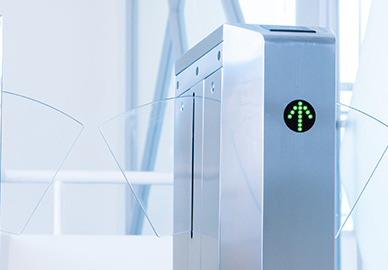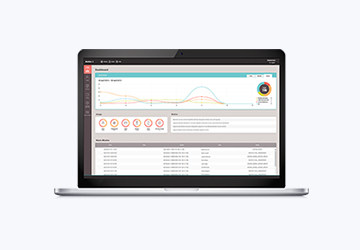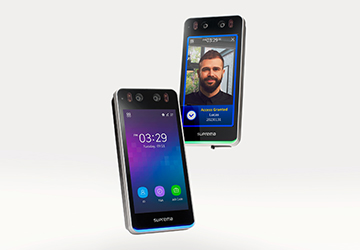- PRODUCTS
- Security Platform
- BioStar X | On-Prem SecurityNEW
- BioStar Air | Cloud Security
- BioStar 2
- Access Control
- Access Control Unit
- Biometric Readers
- RFID Readers
- Mobile Credential
- Peripherals
- Wireless Door Locks
- SOLUTIONS
- SUPPORT
- ABOUT
- device_hubHUB
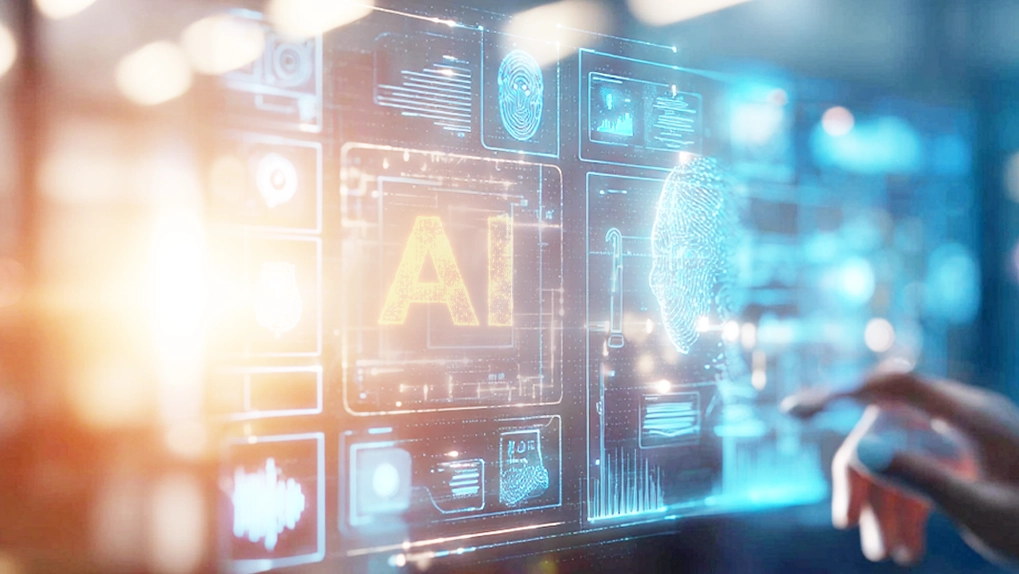
Is your office secure?
Every morning at 9 AM., hundreds of employees pass through the busy office lobby. Some nod at familiar faces, others exchange brief greetings, while many keep their heads down and hurry through the access points. Inside the security control room, operators diligently monitor numerous CCTV feeds, but with dozens of screens and countless people moving simultaneously, it becomes impossible to catch every unexpected behavior or anomaly.
According to a study by Matryx Consulting, a single CCTV operator may miss about 45% of anomalies after 12 minutes of continuous monitoring, and the miss rate can reach up to 95% after 22 minutes[1]. In that brief moment, a stranger could slip unnoticed into the elevator, suspicious objects left unattended on the 22nd floor could go undetected, and unusual activity in the parking garage might be ignored entirely. These gaps present real security vulnerabilities.
The challenge is clear: how can we overcome the limits of human attention while keeping security friction-free?

In 2025, the answer is AI. Verified Market Research projects that the global video analytics market will grow at an average annual rate (CAGR) of 21.5% from 2021 to 2030[2]. Facial recognition, in particular, has achieved accuracy rates above 99.7%, according to testing by the U.S. National Institute of Standards and Technology (NIST)[3]. Leading this transformation is Suprema’s AI-driven video analytics and facial authentication technology.
AI-Powered Security, Beyond Human Limits
Suprema’s AI is like a tireless security officer—one who never blinks, never misses an anomaly, and can monitor dozens of locations at once. Imagine a guard who remembers 1,000 faces per day, instantly spots behavioral red flags, and recognizes potential threats before they escalate. That is what Suprema’s AI delivers.
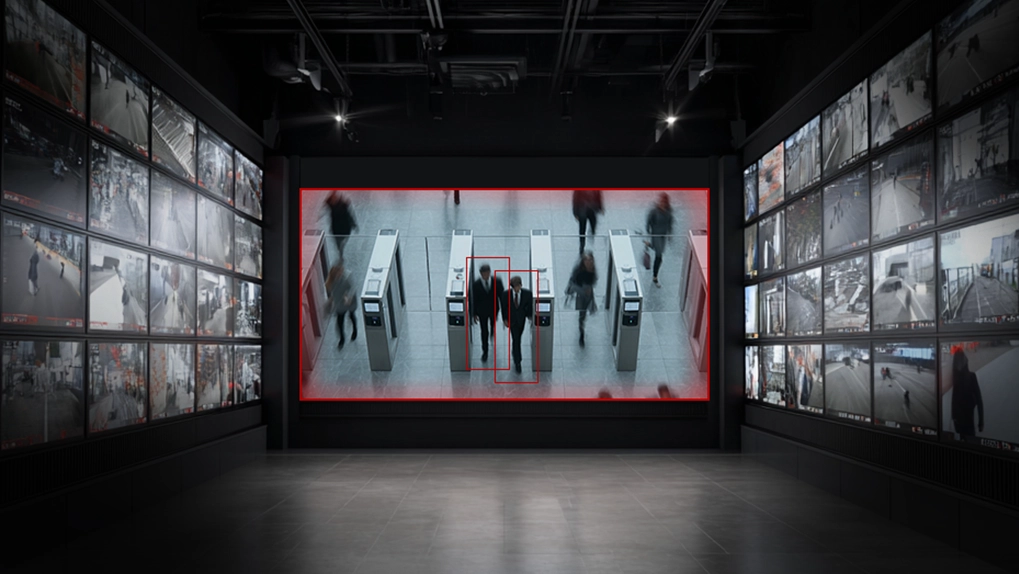
[AI based tailgating detection]
Unlike humans, who can tire or lose focus, AI remains sharp and vigilant 24/7. Developed entirely at Suprema’s R&D center, this proprietary algorithm accurately authenticates authorized users only and detects various behaviors, including intrusion, loitering, collapse, abandonment, and violence. Additionally, it offers advanced features such as tailgating (when unauthorized individuals follow authorized personnel through access points) and weapon detection.
Designed for flexibility, the algorithm can be deployed as a module or plugin, allowing seamless integration into a wide range of industries and existing security infrastructure.
25 Years of AI Innovation at Suprema
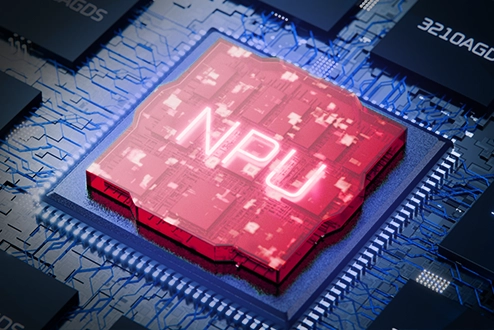
Suprema’s journey in artificial intelligence spans 25 years of continuous innovation in biometrics and access control. The company first gained global recognition in the early 2000s by pioneering fingerprint recognition technology and has since invested in developing proprietary biometric authentication algorithms.
Over time, Suprema’s focus expanded from fingerprints to facial recognition and now to advanced multimodal authentication.
Leveraging this extensive experience, Suprema delivers industry-leading AI authentication performance, validated by decades of field deployment and proven reliability across diverse environments.
Notably, Suprema was an early adopter of neural processing units (NPUs) for edge AI devices. NPUs are specialized chips designed to accelerate artificial neural network computations, enabling efficient processing directly on the device rather than relying on cloud-based systems. This approach embeds Suprema’s proprietary deep-learning engine directly into its devices, enabling efficient, high-speed processing of large datasets with lightweight AI, without causing device overheating or slowdowns.
Through this integration of AI expertise, hardware optimization, and unmatched authentication accuracy, Suprema has firmly established itself as a global leader in AI-powered security solutions.
[AI based abnormal behavior analytics]
Predictive Security: AI That Predicts, Not Just Responds
The real breakthrough in security comes from the ability to predict threats before they happen, rather than just reacting afterwards. Traditional security systems only respond once an incident occurs, but Suprema’s AI looks ahead. It detects early signs of risks such as unusual access attempts, people scouting the area, or unauthorized movements, and alerts security teams before these lead to problems.
For instance, someone pacing repeatedly around the fence may appear harmless on ordinary CCTV. But AI can flag the behavior as potentially suspicious. If an employee accesses restricted areas at 2 AM or repeats failed entry attempts, AI marks it as abnormal and warns security staff in advance. In urgent scenarios, AI detects weapons or violent acts instantly and triggers alerts.
Where human eyes may falter, AI ensures nothing is overlooked.
By predicting threats early, AI helps prevent incidents before they escalate. This gives security teams valuable time to act proactively, use resources more efficiently, and keep people and property safer. As security challenges grow more complex and sophisticated, relying on AI for predictive security is not just smart—it's becoming essential for effective protection in the modern world.
Responsible AI, Trusted Security
AI in security requires great responsibility and careful implementation. Suprema adheres to the highest standards, including ISO/IEC 27001 for information security management and ISO/IEC 27701 for privacy information management. These international standards ensure that data is handled securely and privacy is protected throughout the system's operation.
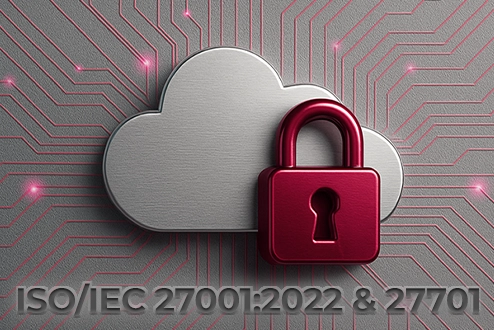
Compliance with the EU's GDPR (General Data Protection Regulation), AI Act, and other global regulations is built into the development process from the ground up. This is supported by advanced encryption methods and privacy-by-design principles, meaning privacy protection is considered at every stage of system development rather than added as an afterthought.
This commitment to "responsible AI" ensures that predictive security solutions remain both effective and trustworthy. Organizations can implement these systems with confidence, knowing they meet the strictest international standards for data protection and ethical AI use.
Additionally, Suprema's AI-powered facial authentication has successfully passed the Presentation Attack Detection (PAD) test conducted by iBeta, an independent testing laboratory. This certification means it meets the ISO/IEC 30107-3 standard, demonstrating robust anti-spoofing capabilities that can reliably prevent attempts to deceive the system using photographs, videos, masks, or other spoofing methods.
The Future Has Already Begun

The security industry is experiencing a fundamental shift from reacting to incidents after they occur to preventing them altogether. By combining more than 25 years of biometric expertise with groundbreaking AI capabilities and an integrated platform approach, Suprema is actively shaping the future of predictive security.
This transformation promises a safer, more convenient future where security systems work intelligently in the background, protecting people and assets while maintaining the smooth flow of daily operations. The technology exists today, the benefits are proven, and organizations worldwide are already experiencing the advantages of predictive security.
The future of security is not just about watching—it's about understanding, predicting, and protecting before threats become reality.
Ready to experience the future of security? Contact Suprema today to learn how our AI-powered behavioral analytics can transform your security operations from reactive monitoring to predictive protection.
[1] Matryx Consulting. (2025). Visual Vigilance Limits in Security Surveillance Environments. Internal briefing paper. [2] Verified Market Research. (2022). Video Analytics Market By Type, By Deployment, By Application, Forecast 2022–2030. [3] NIST FRVT. (2021). Face Recognition Vendor Test (FRVT) Part 2: Identification. Retrieved from www.nist.gov










